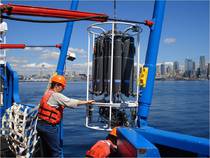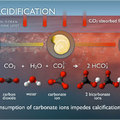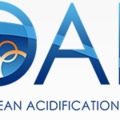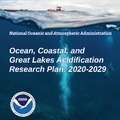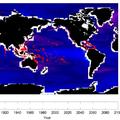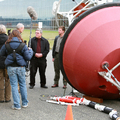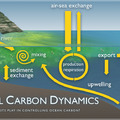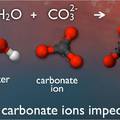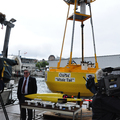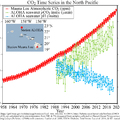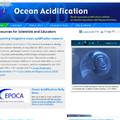OA Research
We seek to understand how OA affects the chemistry of the oceans and its marine ecosystems
North Pacific
Repeat hydrography cruises in the North Pacific Ocean documenting changes in pH over 34o of latitude, 6000 m of depth, and 15 years of time, confirm significant upper ocean acidification, roughly keeping pace with rising atmospheric carbon dioxide. It appears that future acidification of the ocean’s mixed layer can be expected to occur at rates that closely mirror changes in atmospheric CO2. Repeat hydrography cruises, such as these in the North Pacific, are critical to documenting these changes and improving ocean biogeochemical models that predict future conditions and inform marine resource management and national policy decisions.
U.S. West Coast
The deep waters of the Northeast Pacific Ocean are considered the “oldest” water in the ocean conveyor belt and carry the cumulative signature of respiration processes that have taken place over the 1,000 years since the water mass was last exposed to the atmosphere. The upwelled waters along the coast are thus naturally rich in CO2 and nutrients and lower in oxygen and pH than the waters they replace. This natural high-CO2 condition is exacerbated by the uptake of anthropogenic CO2 at the surface.
However, historical carbon measurements along the West Coast have been infrequent and localized, with the exception of the 2007 North American Carbon Program West Coast Cruise. During this cruise, we observed seawater undersaturated with respect to aragonite upwelling onto large portions of the continental shelf, reaching depths of approximately 40-120 m along most transect lines and all the way to the surface on one transect off northern California. While seasonal upwelling of the undersaturated waters onto the shelf is a natural phenomenon in this region, the ocean uptake of anthropogenic CO2 has increased the areal extent of the affected area.
The combination of natural processes and anthropogenic CO2 may make the coastal marine ecosystem on the U.S. West Coast particularly vulnerable to ocean acidification impacts. For example, there was a near total failure of developing oysters in Pacific Northwest hatcheries in recent years. Low pH may be a factor in the current oyster reproductive failure; however, more research is needed to disentangle potential acidification effects from other risk factors, such as episodic freshwater inflow, pathogen increases or low dissolved oxygen.
Arctic
The Arctic Ocean is a sentinel region for signs of ocean acidification. Corrosive waters reach shallower depths more so there than in any other ocean, and so impacts of ocean acidification on marine calcifiers will likely occur earlier there than in many other places. Ocean pH measurements in the Arctic are sparse, so we are working to expand our observation network into Arctic Ocean waters off Alaska to monitor the progression of ocean acidification and the impact on the unique marine ecosystem.
Puget Sound
Very little research has been done on how the impacts of ocean acidification may be manifested in estuaries and near shore coastal areas. In 2008, the PMEL Carbon Group began to collaborate with scientists from the University of Washington and the Washington State Department of Ecology to conduct the first extensive high-quality carbon surveys in Puget Sound and found evidence suggesting that OA and other anthropogenic stressors are having synergistic negative impacts on this rich ecosystem. The research team estimated that ocean acidification accounts for roughly a quarter to half of the pH decrease in the deep waters of the Hood Canal sub-basin of Puget Sound relative to estimated pre-industrial (before 1800) values. The remaining change in pH between when seawater enters Puget Sound and when it reaches this deep basin results from the decomposition of organic matter. Biologists are currently working with the oyster hatchery industry in this region to determine whether corrosive seawater is affecting shellfish populations.
See the links below to learn more about ocean acidification and the type of research our group is involved in.

